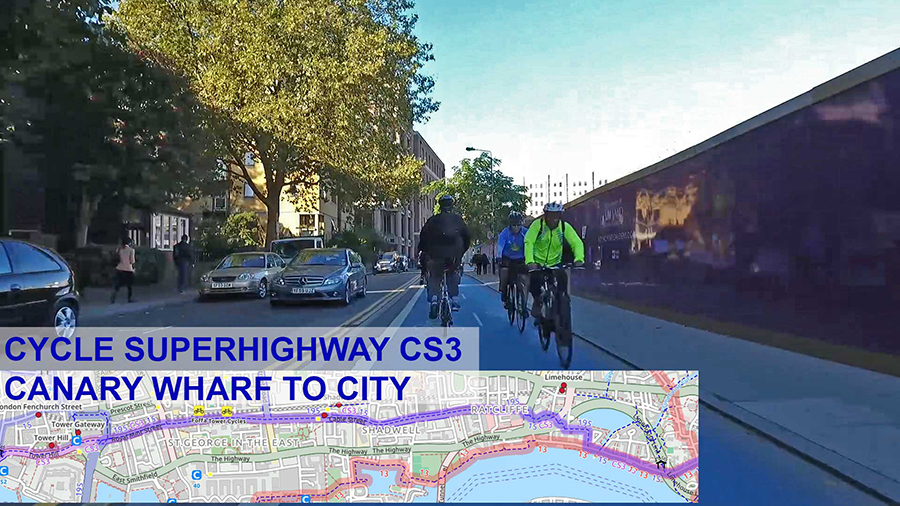Cycle Superhighway CS3 from Canary Wharf to the City of London via Cable Street is the busiest
If you would like to do an assessment of this section of CS3, please retain your impartiality by doing the assessment before reading the post or watching the video. List of 18 London cycling posts and videos.
[yasr_visitor_multiset setid=0]
![]() The section of Cycle Superhighway CS3 between Canary Wharf and the City is said to be the busiest cycle route in the UK and could therefore contribute more to public health than any other street in London. Though most of it is ugly, narrow and badly surfaced, it has significant virtues. First, it’s a direct route between two financial centres. Second, it’s a key component in the wider pattern of East London’s cycle network, used by commuters from north and south of the river. Third, the section through St James Gardens is a pleasant surprise. It’s fresh, it’s green and it has seats for those who want a rest – which is what you need before and after crossing Butcher Row.
The section of Cycle Superhighway CS3 between Canary Wharf and the City is said to be the busiest cycle route in the UK and could therefore contribute more to public health than any other street in London. Though most of it is ugly, narrow and badly surfaced, it has significant virtues. First, it’s a direct route between two financial centres. Second, it’s a key component in the wider pattern of East London’s cycle network, used by commuters from north and south of the river. Third, the section through St James Gardens is a pleasant surprise. It’s fresh, it’s green and it has seats for those who want a rest – which is what you need before and after crossing Butcher Row.

The Cable Street section is as straight as the railway it parallels. But like the whole of this section, it needs is a re-design. The case for three-metre-wide lanes in each direction is strong because:
- the volume of cycle traffic is high
- the volume is fast growing
- the flows of cycle traffic are less-tidal than in most of London. This is because there are important destinations at both ends of the route.
Cable Street should be redesigned to make it an urban cycling greenway and a pleasure to use. Cyclists also like having comfortable street furniture for when they stop to make phone calls or to drink coffee.
Access for motor vehicles should be on a residents only basis, with through traffic guided to use The Highway and Commercial Road.
Car parking should be allowed only if there is spare road space after creating the cycle lanes in each direction. Parking isn’t allowed on busy motor roads and shouldn’t be allowed on busy cycle roads. Is the plan to wait for cyclists to start banging into each other before creating more space for cycling?
Cable Street has an interesting history which could inspire an urban landscape design. In 1936 it was the scene of Britain’s first successful battle against fascism. Some 20,000 demonstrators turned back 3,000 fascists – who were protected by 6,000 police officers. This led to a change in the law on public demonstrations.
In the 19th century, the area had specialised trades in nautical equipment, cheap lodgings, brothels, and opium dens. The ‘cables’ which gave the street its name were hemp ropes made for ships. What about putting an overhead cable along the street for climbing plants?
In 1812 the last English sinner to have a stake driven through his heart was buried, upside down, beside Cable Street. It was a punishment for his alleged offence of committing suicide. It’s not quite certain that he did it. But the fact that a good landscape design could make Cable Street a charming multi-purpose greenway IS quite certain. Let’s have a budget – and a design competition. The investment would do even more good for Europe’s financial centre than bankers’ bonuses.

